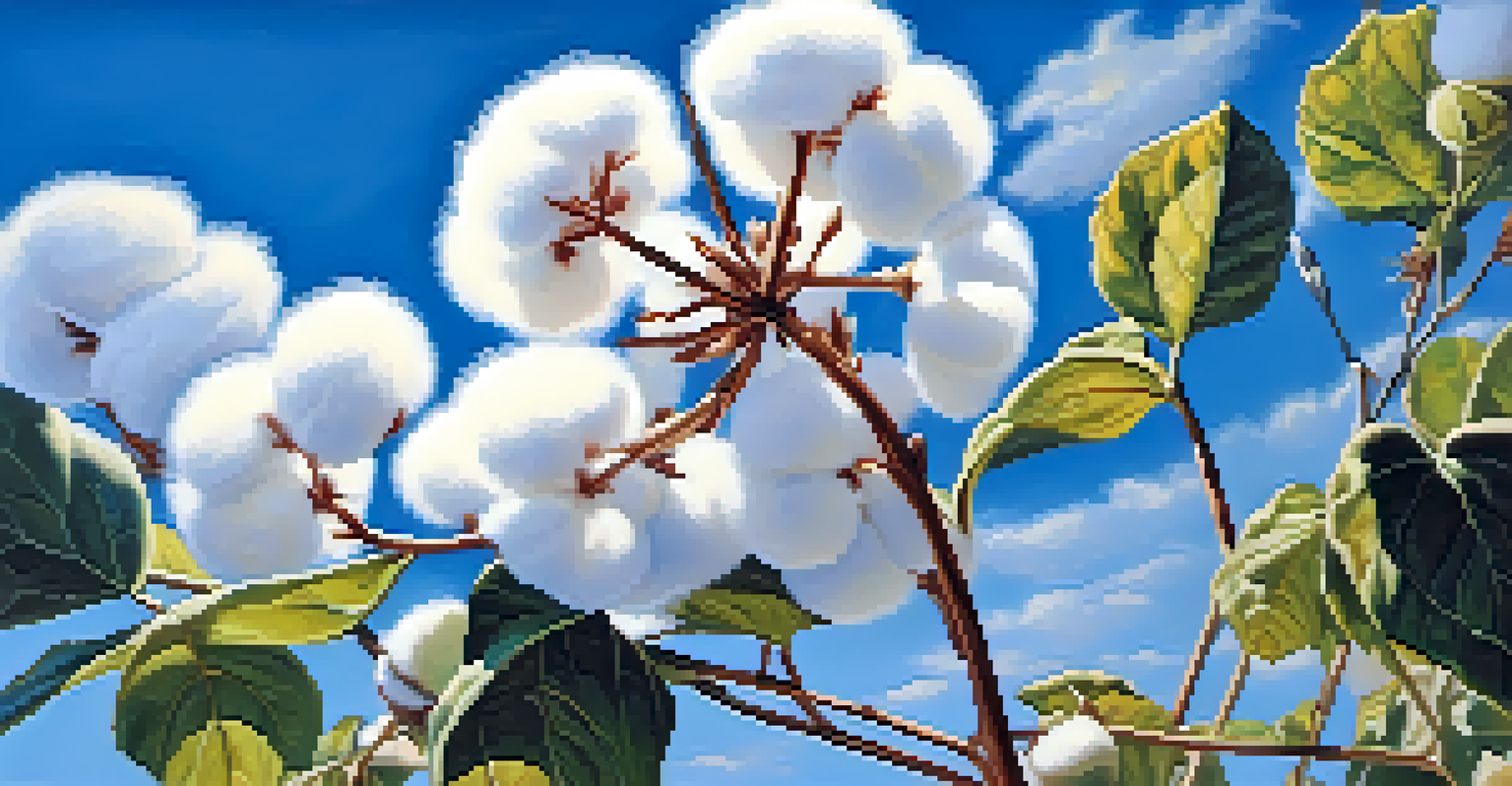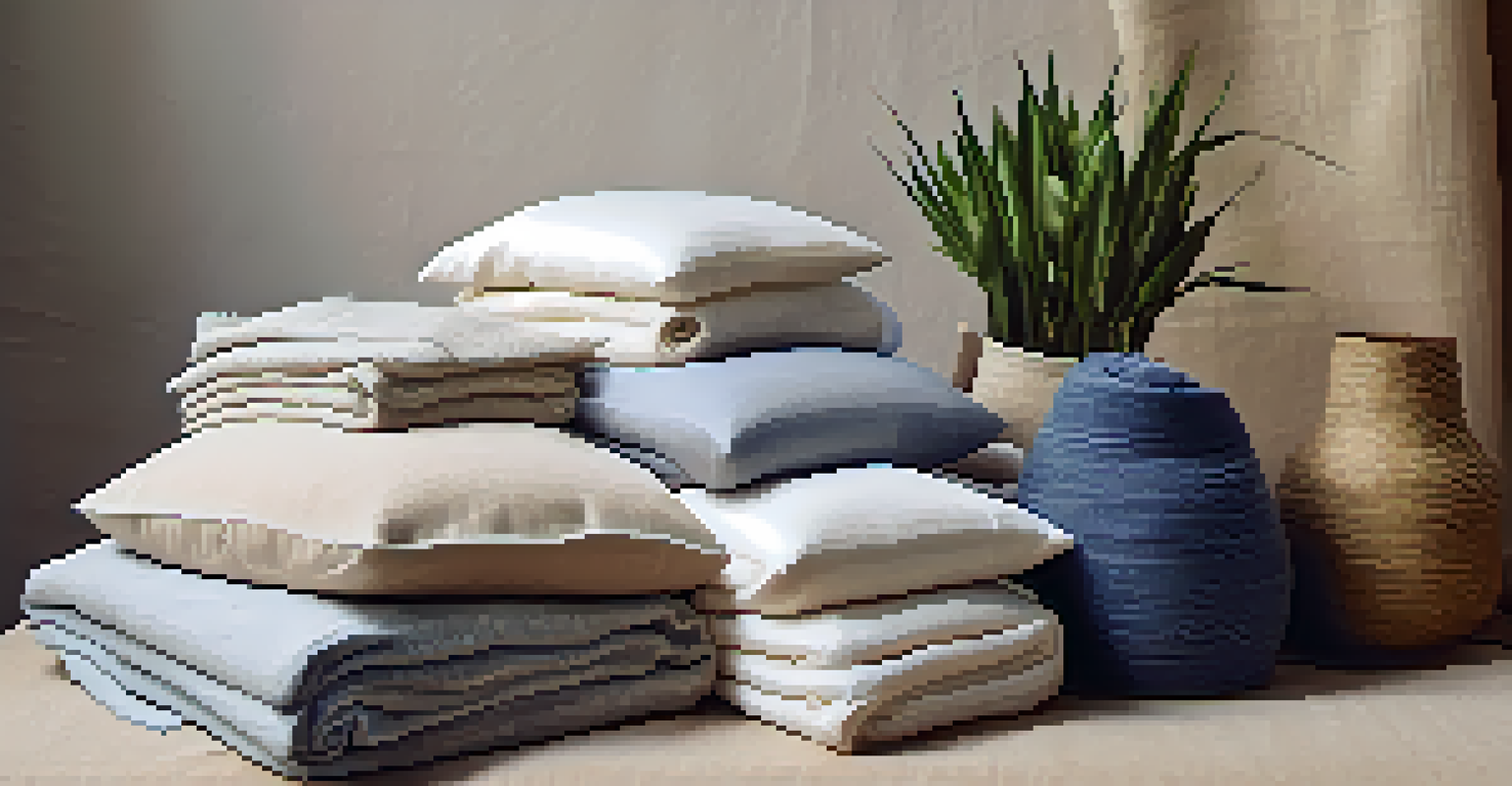Exploring the Durability of Plant-Based Textile Materials

Understanding Plant-Based Textiles and Their Origins
Plant-based textiles are materials derived from natural sources such as cotton, hemp, and bamboo. These fabrics are not only eco-friendly but also offer a unique blend of comfort and durability. Unlike synthetic fabrics, which are petroleum-based, plant-based textiles are renewable and biodegradable, making them a more sustainable choice for consumers.
Fashion is about something that comes from within you.
The journey of plant-based textiles begins in the fields where crops are cultivated. For instance, cotton is harvested from the cotton plant, while linen comes from the flax plant. This natural sourcing contributes to the authenticity of these materials, allowing them to breathe and absorb moisture, enhancing comfort for the wearer.
As more consumers seek sustainable fashion options, understanding the origins of these textiles helps highlight their environmental benefits. By choosing plant-based fabrics, individuals can support agricultural practices that are less harmful to the planet and contribute to a greener future.
The Strength of Natural Fibers Compared to Synthetics
When it comes to durability, plant-based textiles often hold their own against synthetic alternatives. For example, hemp is known for its exceptional strength and resistance to wear and tear, making it an excellent choice for long-lasting garments. Interestingly, some cotton fabrics can be just as durable, especially when they are tightly woven.

Conversely, synthetic fibers like polyester may have their own advantages, such as moisture-wicking properties. However, they can be prone to pilling and may not withstand the test of time like their natural counterparts. This comparison highlights the importance of selecting the right fabric for specific uses, ensuring both comfort and durability.
Plant-Based Textiles Are Sustainable
Derived from natural sources, plant-based textiles are eco-friendly, renewable, and biodegradable, making them a better choice for the environment.
Ultimately, the decision between plant-based and synthetic textiles comes down to personal preference and intended use. For those seeking longevity and a lower environmental impact, plant-based options often emerge as the superior choice.
The Role of Processing in Textile Durability
Not all plant-based textiles are created equal; the processing methods play a significant role in their durability. For instance, organic cotton undergoes fewer chemical treatments than conventional cotton, resulting in a softer and more resilient fabric. This minimal processing not only benefits the environment but also enhances the fabric's lifespan.
The greatest threat to our planet is the belief that someone else will save it.
In contrast, some plant-based materials may be subjected to harsh chemicals during production, which can weaken the fibers and reduce their overall durability. It’s essential for consumers to be informed about the processing methods used in the textiles they choose, as this can directly impact the quality and longevity of the products.
As awareness of sustainable practices grows, many brands are shifting towards eco-friendly processing methods. This change promises not only to improve the durability of plant-based textiles but also to align with the values of environmentally-conscious consumers.
Care and Maintenance of Plant-Based Textiles
Caring for plant-based textiles is crucial for maintaining their durability over time. Generally, these fabrics can be machine washed, but it’s advisable to follow specific care instructions to avoid unnecessary wear. For instance, washing in cold water and air drying can help preserve the integrity of the fibers.
Additionally, avoiding harsh detergents and fabric softeners can prolong the life of these textiles. Natural fibers can be sensitive to chemicals, which may cause them to break down more rapidly. By opting for gentle, eco-friendly cleaning products, consumers can protect their investment in sustainable fashion.
Durability of Natural vs. Synthetic
Natural fibers like hemp often outperform synthetic fabrics in durability, offering long-lasting options for consumers.
Understanding proper care techniques can empower consumers to make informed decisions about their clothing. With the right maintenance, plant-based textiles can remain vibrant and durable, providing value and comfort for years to come.
Environmental Impact of Plant-Based Textiles
The environmental benefits of plant-based textiles extend beyond their biodegradability. For instance, the cultivation of natural fibers like hemp requires less water and pesticides compared to conventional cotton farming. This reduced environmental footprint contributes to healthier ecosystems and promotes biodiversity.
Moreover, plant-based textiles support the reduction of carbon emissions. As plants grow, they absorb carbon dioxide, thus playing a crucial role in combating climate change. By choosing plant-based options, consumers not only make a fashion statement but also participate in a larger movement towards sustainability.
However, it's important to recognize that not all plant-based textiles are equally sustainable. Factors such as farming practices and processing methods can significantly influence their overall impact. Therefore, informed choices are essential for maximizing the benefits of plant-based textiles.
Innovations in Plant-Based Textile Technology
The textile industry is witnessing exciting innovations that enhance the durability of plant-based materials. For example, advancements in fiber technology are enabling the development of stronger, more resilient fabrics from natural sources. Innovations such as blending different plant fibers can result in textiles that combine the best qualities of each material.
Additionally, researchers are exploring the potential of new plant sources for textiles, such as pineapple leaves and banana fibers. These materials not only offer unique textures and aesthetics but can also be engineered to improve durability and performance in various applications.
Innovation Enhances Textile Quality
Advancements in textile technology are leading to stronger, more resilient plant-based fabrics, supporting the demand for sustainable fashion.
As the demand for sustainable fashion continues to grow, these innovations present an opportunity for brands to offer high-quality, durable plant-based textiles. By embracing technology while respecting nature, the textile industry can pave the way for a more sustainable future.
The Future of Plant-Based Textiles in Fashion
Looking ahead, plant-based textiles are poised to play a significant role in the future of fashion. With consumers increasingly prioritizing sustainability and ethical practices, brands are adapting by incorporating more plant-based materials into their collections. This shift not only reflects changing consumer values but also encourages innovation within the industry.
As plant-based textiles gain popularity, we can expect to see more collaborations between fashion brands and sustainable textile producers. These partnerships can lead to the creation of unique, high-quality products that highlight the benefits of using natural fibers while maintaining durability and style.

Ultimately, the future of fashion lies in a harmonious blend of aesthetics and sustainability. Plant-based textiles offer a promising pathway toward achieving a more eco-conscious industry, where durability and style go hand in hand.